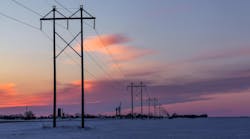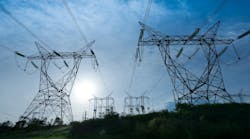In the earliest days of the power grid, wood provided the essential bones of the beast -- cross arms, braces, guy guards and molding. Today, while utilities also build with steel, fiberglass and other materials, the unique qualities of wood continue to make it an essential building material for the electric infrastructure. Knowing how to buy, deploy and manage wood throughout its entire lifecycle remains vital knowledge for utilities looking to get the most out of their investment.
Where Wood Works Well
Like any product, the key to using wood materials begins with understanding the right circumstance for choosing the material.
A July 2017 T&D World story tells how, after a 2016 summer storm near Minneapolis, Xcel Energy discovered “two 8.5-mile (13.7-km) parallel sections of 345-kV line — with 54 H-frame structures on each line” lying on the ground. Should they rebuild with wood or steel? Practical factors guided the materials choices. One line needed to be restored immediately. For this line “wood construction was chosen to rebuild the Monticello line based on material availability and past experience with wood construction in these wet conditions.” In this case, the word “Resiliency” meant more than long life, it meant getting power back in a much shorter time frame.
Because the second “line rebuild could wait, the engineering department had time to explore other options for its replacement,” eventually choosing a steel product for the other half of the restoration. The utility’s experience is a good example of selecting the right use case for wood.
Wood can be a superior alternative to steel or fiberglass. Wood braces, for example, provide superior mechanical strength while meeting important BIL requirements. Similarly, a wooden Hughes Alley Arm Brace delivers greater strength than a formed angle iron brace, with less weight.
Douglas Fir, the gold standard for solid wood utility infrastructure, is a material with tremendous resistance to sun damage. Its deterioration rate is a mere quarter inch per century. This makes it an ideal product in areas of high UV radiation. Wood guy markers work especially well, significantly outlasting most resin based, plastic guy guards.
Buy Smart: Evaluating Quality in Wood
What’s the best way to recognize quality in the wood you buy for your infrastructure?
Visual grading has long been a key approach to rating sawn wood. Characteristics such as rate of growth, seasoning checks, slope of grain, pitch pockets, rot and knots remain vital to understanding the quality of wood. While some say that newer wood is of lesser quality than old, it’s important to know that since grading standards have remained unchanged over the past century, wood of a verified grade is the same quality as ever. Glue laminated wood is an effective and popular alternative to sawn lumber and also offers consistent strength properties and lower moisture content.
Wood standards vary by type of product. Utility cross arms, for example, must be made of thoroughly seasoned timber with a moisture content determined to meet American Wood Preservers Association (AWPA) standards.
How it’s Made Matters
Certain production techniques can further enhance the strength of wood for utility infrastructure. Treating the exposed fibers of wood has in some cases extended the life span of components like cross arms to over fifty years. Hughes uses proprietary Hughes P9 oil with Pentachlorophenol in pressure treating. The manufacturer has two large “retorts” for pressure treating (40 and 65 feet long, each).
Incising – small incisions made on all faces of cross arms to aid in penetration of preservative and relieve surface tension of wood fiber – can also reduce the possibility of surface checks. Hughes operates its own preserving facility in accordance w/EPA guidelines on site.
Buyers should conduct an inspection either at the point of manufacture or upon delivery. Hughes has maintained a world-class quality standard with returns under .02% of orders.
Build it Right
Engineering the right product requires experience. Hughes Brothers draws on knowledge and records from nearly a century of testing and building hundreds of different components and structures. The now iconic X-brace invented by Hughes Brothers around 1929 improves resiliency. Its development was an early example of how full-scale testing can be used to this day. Full-scale tests of x-braced frames showed a drop in top deflection from 58 inches to 6 inches and increased the overall framing strength from 4,060 pounds to 13,600 pounds.
Other examples of quality wood construction include tapping steel fitting holes to ensure that even as timber shrinks over time, connections remain tight and RF interference does not occur. Similarly, wood structures built with metal connections allow full drainage of moisture, leaving no place for decay to develop.
Maintain and Test Over Time
While the lifespan of wood infrastructure is considered by some to be 25-40 years, in practice, it may last much longer. How can utilities reliably assess the strength and resiliency of older assets?
Visual assessments help of course. Most utilities schedule regular inspections of the wood arms, poles and other assets in the field. This is crucial for correcting loose or missing hardware and doing proper vegetation management.
Destructive testing can also be done to assess existing framing. In destruction tests for one utility, Hughes tested wood structures nearly 40 years old. Elements including H-frames, poles and cross arms were taken from the field, re-installed exactly in formation at the test site, and subjected to vertical and transverse loading to the point of failure.
The surprising result showed poles still at 100 percent capacity, needing only braces and some structural modifications to extend their service life even further. Armed with this knowledge, the utility was able to spend only about $1,000 to upgrading these elements. It secured more than 20 more years of life from structures that would have cost around $50,000 each to replace.
Wood has unique qualities that continue to make it relevant. In addition to its beauty, the lower initial cost and low electrical conductivity of wood give it appeal for safety and value-conscious buyers. Its relatively low maintenance needs and significant durability give it staying power.
For more information on choosing, maintaining or testing wood for your electrical infrastructure, click here or call Hughes Brothers 402-643-2991.


